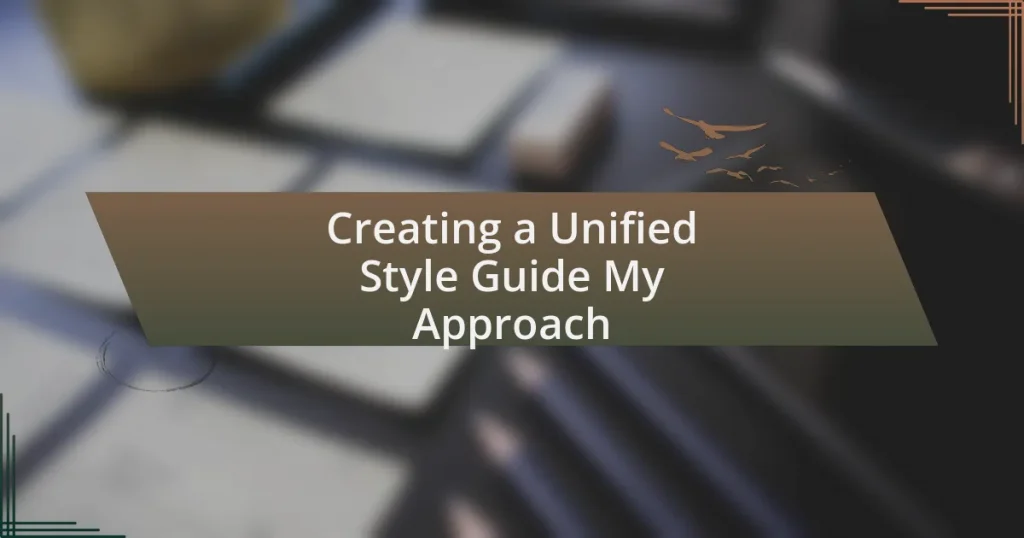Key takeaways:
- Researching existing style guides provides essential insights and inspiration for developing a unique style guide.
- Defining brand voice involves considering tone, language, personality traits, audience connection, and consistency.
- A well-structured style guide template should include typography, color palettes, logo usage, and imagery guidelines to ensure cohesive branding.
- Incorporating visual elements enhances brand identity and storytelling, making it crucial to establish clear visual guidelines and examples.
Researching existing style guides
When I started developing my own style guide, I realized that looking into existing ones was invaluable. I often found myself poring over the AP Stylebook and Chicago Manual of Style, both of which offered a wealth of information. These guides not only provided a solid foundation but also inspired me to think critically about what aspects I wanted to adopt or adapt for my needs.
Digging into various style guides can feel overwhelming, but it’s like piecing together a puzzle. I remember stumbling upon a niche style guide created by a small nonprofit organization. Their focus on inclusivity and accessibility opened my eyes to the potential of shaping content that truly resonates with the audience. Doesn’t it make you think about how much a thoughtful guide can influence communication?
Reflecting on my research journey, I found that it was more than just a technical exercise; it fueled my passion for clarity in writing. By comparing different guides, I discovered unique practices that sparked my creativity. It makes you wonder: what elements will resonate the most with your audience as you shape your guide?
Defining your brand voice
Defining your brand voice is one of the most exciting yet daunting parts of creating a cohesive style guide. I remember when I first attempted to articulate my brand’s voice—it felt like trying to catch smoke with my bare hands. I needed clarity on how I wanted to sound before I could write consistently. To truly capture the essence of your brand voice, think about the emotions and values you wish to convey.
Here are some key elements to consider when defining your brand voice:
– Tone: Should it be formal, casual, or a mix of both?
– Language: What type of vocabulary resonates with your audience?
– Personality Traits: Is your brand humorous, serious, or empathetic?
– Audience Connection: How do you want your audience to feel when they engage with your content?
– Consistency: What guidelines ensure uniformity across different platforms?
As I navigated this process, I found that the smallest details shaped the overall impact of my communications. It’s fascinating how even a slight tweak in tone can change the entire perception of a message. By deliberately defining these attributes, you create a framework that not only guides your writing but also nurtures a deeper connection with your audience.
Creating a style guide template
Creating a style guide template involves laying down a foundation that’s both comprehensive and easy to follow. I vividly remember crafting my first template; I spent hours dissecting successful guides from brands I admired. It became clear that a well-structured template should encompass elements like typography, color palettes, and logo usage, ensuring that all team members are on the same page.
A comparison table can also enhance clarity and facilitate understanding of these components. I found it useful to create side-by-side comparisons of different design elements based on their intended usage. This approach not only simplified my decisions but also helped others visualize the brand’s direction more effectively.
Having a cohesive template allows you to avoid the confusion that arises from inconsistent branding. When I reflect on my early struggles with colors and fonts that didn’t quite fit the brand, it’s clear that consistency is key. A clearly defined template can eliminate those missteps and streamline the design process for everyone involved.
| Element | Details |
|---|---|
| Typography | Select fonts, sizes, and styles that reflect your brand. |
| Color Palette | Define primary and secondary colors for visual consistency. |
| Logo Usage | Outline rules for logo placement and sizing. |
| Imagery | Establish guidelines for photography and graphics. |
| Voice and Tone | Include examples of brand voice and tone in different contexts. |
Incorporating visual elements
Incorporating visual elements into your style guide is crucial for creating a strong brand identity. I remember the first time I introduced visual guidelines. It was a game-changer—suddenly, our designs felt harmonious, like they belonged together. Establishing clear rules for images, such as how to use illustration and photography style, not only enhances your brand’s story but also brings life to your guide.
When choosing visual elements, think about the emotional response you want to evoke. For instance, I often use vibrant colors to instill energy and positivity within my brand’s visuals. Have you considered how color impacts mood? Even the smallest decisions, like the shape of a button or the style of a graphic, can subtly communicate your brand values.
Additionally, integrating examples of approved visuals can help guide team members in the right direction. I once created a visual library filled with ‘do’s and ‘don’ts,’ showcasing our brand in action. This resource made it easy for new designers to grasp our aesthetic quickly, eliminating guesswork and fostering a collaborative environment. Remember, visuals aren’t just pleasing; they are powerful storytelling tools that shape perceptions.
